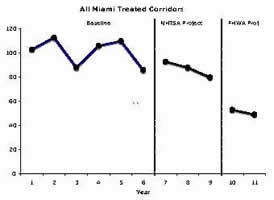U.S. Department of Transportation
Federal Highway Administration
1200 New Jersey Avenue, SE
Washington, DC 20590
202-366-4000
http://safety.fhwa.dot.gov/ped_bike/pedforum/
Each year pedestrian fatalities comprise about 11 percent of all traffic fatalities and there are approximately 4,600 pedestrian deaths. Another 70,000 pedestrians are injured in roadway crashes annually. Safety is important for all roadway users, and the Federal Highway Administration (FHWA) Office of Safety has established a goal of reducing pedestrian fatalities and injuries by 10 percent by the year 2011. Pedestrian safety improvements depend on an integrated approach that involves the 4 E’s: Engineering, Enforcement, Education, and Emergency Services. The Pedestrian Forum highlights recent pedestrian safety activities related to the 4 E’s that will help reach FHWA’s safety goals and save lives.
President Obama and USDOT Secretary Ray LaHood have stated that improving “livability” of communities is one of the Administration’s top transportation priorities. For those unfamiliar with the term “livability,” if refers to enhancing the economic and social well-being of all citizens by creating and maintaining a safe, reliable, intermodal and accessible transportation network that enhances choices for transportation users, provides easy access to employment opportunities and other destinations, and promotes positive effects on the surrounding community. Recent USDOT initiatives to promote livability include:
 Formation of a working group to develop a policy statement and to look at where livability initiatives can be incorporated into DOT policies and programs.
Formation of a working group to develop a policy statement and to look at where livability initiatives can be incorporated into DOT policies and programs.In his remarks to Congress, Secretary LaHood mentioned that the expiration of SAFETEA-LU (the most recent transportation legislation) on October 1 of this year offers several ways in which USDOT can promote livability in the long term:
On March 11th, Secretary LaHood gave opening remarks at the Bike Summit in Washington, DC where he made several positive statements about bicycling and livability in general. The video of his remarks can be seen here. He also completed a blog entry about attending the Bike Summit.
Pedestrian fatalities tend to be sporadic events that don’t typically occur all at the same location or under the same conditions, making it hard to figure out a way to minimize them. In an attempt to come up with a solution to this problem, the FHWA awarded grants to the cities of San Francisco, Las Vegas and Miami in 2003 to develop plans for deploying and evaluating various pedestrian safety countermeasures in high crash “zones” and locations. The purpose of the project was to demonstrate how a city could improve pedestrian safety by performing a detailed analysis of its pedestrian crash problem, identifying and evaluating high crash locations, observing factors such as driver and pedestrian behavior, and deploying various lower cost countermeasures tailored to the site. An independent evaluation was also conducted to compare the countermeasure deployment across the three cities.
 Since it takes a few years for the effects of a treatment to make an impact on crashes, crash data was not yet available for San Francisco and Las Vegas at the conclusion of the project. Instead researchers mainly looked at “measures of effectiveness (MOE)” related to pedestrian and driver behavior to determine if there was a safety improvement. Using these MOEs and comparing them across sites, it was determined that there were seven countermeasures that were highly effective in improving pedestrian safety: leading pedestrian interval; pedestrian countdown signals; in-street pedestrian signs; activated flashing beacons; rectangular rapid flash beacon; call buttons that confirm the press; and Danish offset combined with high visibility crosswalk, advance yield markings, and YIELD HERE TO PEDESTRIANS signs.
Since it takes a few years for the effects of a treatment to make an impact on crashes, crash data was not yet available for San Francisco and Las Vegas at the conclusion of the project. Instead researchers mainly looked at “measures of effectiveness (MOE)” related to pedestrian and driver behavior to determine if there was a safety improvement. Using these MOEs and comparing them across sites, it was determined that there were seven countermeasures that were highly effective in improving pedestrian safety: leading pedestrian interval; pedestrian countdown signals; in-street pedestrian signs; activated flashing beacons; rectangular rapid flash beacon; call buttons that confirm the press; and Danish offset combined with high visibility crosswalk, advance yield markings, and YIELD HERE TO PEDESTRIANS signs.
In Miami, MOEs were also used, but crash data was available. The National Highway Traffic Safety Administration (NHTSA) had a study in Miami to look at the effects of implementing law enforcement and education programs on crash data prior to the start of FHWA’s project. Data were collected for each corridor for 6 years prior to the introduction of the NHTSA project, for the 3 years that the NHTSA project was implemented, and for an additional 2 years that FHWA’s project was implemented--providing a total of 11 years of crash data along these high crash corridors. The installation of the engineering countermeasures on top of the NHTSA education and enforcement efforts lead to a remarkable 50% reduction in pedestrian crashes, as illustrated in the figure in the preceding column.
Overall, it appears the project was successful in demonstrating that a locality can implement targeted low cost improvements and have an impact on its pedestrian safety problem; only about $1 million was spent over the six year period by each city on the countermeasures implemented. The in-depth final reports from each location as well as the independent evaluation are available for viewing at: http://safety.fhwa.dot.gov/ped_bike/tools_solve/ped_scdproj/.
There will be a free webconference on Thursday, May 28 from 1:30 to 3:30 Eastern Time to discuss the project and answer questions. Those interested in participating should contact tamara.redmon@dot.gov for details.
Volpe Transportation Center just completed an evaluation of FHWA's efforts to improve safety in the Pedestrian Safety Focus States and Cities. Overall, the evaluation was very positive and documented the changes that had come about in the focus states and cities as a result of the technical assistance that has been provided over the last several years. Some of these changes include changes in policy within the states and cities to improve conditions for pedestrians; equipping engineers and planners with information they could use to accommodate pedestrians and improve safety; engineering improvements to some of the locations in which those attending the courses had recommended improvements, and many more. The final report can be viewed here: http://safety.fhwa.dot.gov/ped_bike/docs/pedevalrpt_020509.pdf.
NHTSA has started tracking “not in traffic” pedestrian and bicycle fatalities (i.e. those that occur in driveways from backing vehicles, etc.) which they did not previously do. So far they have found an additional 600 pedestrian and bicycle accidents per year, which means there are at least 13% more ped/bike fatalities then previously thought. A report is available on the NHTSA website: http://www.nhtsa.gov/DOT/NHTSA/NCSA/Content/NiTS/811085.pdf
Funding is now available to communities interested in making their environment more “walkable” for residents. The Highway Safety Research Center (HSRC) is seeking proposals for up to 10 communities or neighborhoods to pilot test the use of a newly developed guidebook on how to improve pedestrian safety in neighborhoods. Each selected site will be provided $2,000 as well as technical assistance from pedestrian safety experts. To download the RFP, please visit http://www.walkinginfo.org/res_guide/
Only government agencies and other not-for-profit organizations and neighborhood groups (such as PTAs, homeowner’s associations, advocacy groups, etc.) are eligible to apply. Project funds are not payable to individuals.
HSRC will conduct a pre-award conference call on Friday, May 1, 2009 at 1 PM ET to offer applicants an overview of the RFP as well as answer questions from applicants. To register for the call, please visit http://www.walkinginfo.org/res_guide/call.cfm.
Completed proposals are due Friday May 29, 2009 by 5 PM ET. Applicants should use the Web-based submission process available at http://www.walkinginfo.org/res_guide/RFP.cfm. HSRC anticipates selecting the awarded communities in mid- July 2009.
Funding for this project is provided by NHTSA. HSRC received funding from NHTSA to pilot test A Resident’s Guide for Creating Safe and Walkable Communities (available for viewing at: http://safety.fhwa.dot.gov/ped_bike/ped_walkguide/). The guide, developed by FHWA, is designed to be used by anyone who is looking for ways to improve the pedestrian safety and walkability of their neighborhood, whether they are just beginning to learn about pedestrian safety or are already part of an established community safety group.
 In 2007, Hillsborough County, Florida had 384 pedestrian-vehicle crashes that resulted in 138 fatalities and incapacitating injuries. To assist in reducing these figures, Hillsborough County recently began an endeavor to create a Pedestrian Safety Action Plan (PSAP). Funded by the District 7 Safety Office at FDOT, this project is a cooperative initiative between FHWA and stakeholder agencies. The PSAP focuses on four main areas for improvement: engineering, education, enforcement, and emergency response. One of the primary goals of the PSAP is to bring together all parties having an impact on these areas to discuss policies and practices that can improve pedestrian safety.
In 2007, Hillsborough County, Florida had 384 pedestrian-vehicle crashes that resulted in 138 fatalities and incapacitating injuries. To assist in reducing these figures, Hillsborough County recently began an endeavor to create a Pedestrian Safety Action Plan (PSAP). Funded by the District 7 Safety Office at FDOT, this project is a cooperative initiative between FHWA and stakeholder agencies. The PSAP focuses on four main areas for improvement: engineering, education, enforcement, and emergency response. One of the primary goals of the PSAP is to bring together all parties having an impact on these areas to discuss policies and practices that can improve pedestrian safety.
To kick off the project, the Florida Department of Transportation hosted a day-long workshop with representatives from the law enforcement, schools, planning agencies, and public works departments. The workshop will be followed up by more tailored meetings with stakeholders—both those attending the workshop and others. The resulting PSAP will provide a blueprint for the implementation of pedestrian improvements throughout the county. Pinellas County is currently working on its plan as well.
This Pedestrian Forum is available on the Web at http://safety.fhwa.dot.gov/ped_bike/pedforum/
To subscribe to the newsletter, send an e-mail to the Editor:
Tamara Redmon, tamara.redmon@dot.gov
Federal Highway Administration
Office of Safety
1200 New Jersey Ave SE, E71-303
Washington, DC 20590
202-366-4077
